Eternally away from Japan (日本よりはるかに、永遠に)
Metaphorically speaking, but OF COURSE I WANNA GO BACK!
But, you better pack a lunch cuz this is gonna be one long post.
And may I recommend using my wife’s Flickr page (http://www.flickr.com/photos/85098170@N00/sets/72157625224338273/) of our trip as a visual companion. I included a set of sketches below, so if you don’t want to read my thoughts on the trip, just scroll all the way down to a modest gallery of drawings. We were literally walking so much and trying to see so much, that I really didn’t even have time to take my sketch journal out of my bag to sketch. But, I think looking at these sketches now certainly helps put things in perspective.Then again, this post is much more a an emotional and stream of consciousness account of what I experienced rather than a day by day diary. So, here we go.
It’s been about 3 (4, now 5) weeks since I got back from my first trip to Japan. And, I was there for about 3 weeks as well, but it felt like a lifetime. Everyday was packed from morning to night, trying to take everything in, trying not to miss a beat of the rhythm of some of Japan’s famous cities; Tokyo, Kyoto, Osaka, and Hiroshima.
Like I mentioned in my previous post, this was a trip I was planning on doing for a long time. I spent much of my undergraduate college studies immersed in Japanese language and culture, and even before that time, I grew up watching Japanese animation and live-action shows from Japan, such that it influenced me and my work consciously and unconsciously. So, in many ways, arriving in Japan felt very familiar, or rather expected, but also new, and something I felt on a visceral level. My wife and I spent our first week in Tokyo, and had our hotel in Ikebukuro, which is probably the best part of Tokyo we could’ve stayed in. The scale of things is definitely different there, and it’s rather difficult to get it or understand until you’re there – everything feels close and at an arm’s reach. I never really felt intimated by the high rise buildings and with the amount of people that constantly surround you, you feel at ease somehow – the population density may have its problems, but I think I prefer that to the rather deserted streets of Los Angeles, where cars roam like tanks, and people are an endangered species. We just don’t really get to experience crowded streets or venues over here.
We made our way through most of the touristic districts of Tokyo, and of course missed many – after all, that’s what happens on everyone’s first visit to a new place. Then, of course, there was the language. Now, to preface this next thought, let me just say that I did study Japanese language at UCLA and I even have a BA in it. But, not until this trip did I really put my skills to the test. Let’s say I got a passing grade on that, and not necessarily because I wasn’t understanding what people were saying or speaking like a novice, but at the same time there was this bug in my head about it.
Japanese is my third language, if English is my second, (Portuguese being my first, but I also spoke French before really beginning how to even speak as a child, so who’s counting?) and the fears and remorse of embarrassment from not being able to communicate freely is what really got me the down the most. It is indeed rather ironic, but more often than not, I think the people at train stations, restaurants, and stores with whom I interacted probably assumed that I had a better control of the language than I actually had, and while when they replied to me I could understand a fairly good amount, it was often frustrating to answer back with nothing but simple phrases of confirmation or doubt. Of course, I wouldn’t say that ruined the trip for me, but for the first few days, I think what I experienced wasn’t really a culture shock but an insecurity shock (I know I can speak Japanese, right? Right?…) Regardless, my kind wife constantly reiterates the fact that without me she’d be totally lost, so I guess there is some solace to be had on that aspect of the experience.
Now, I can’t go on talking about Japan without talking about what it means to me artistically. It’s almost impossible to separate the various aspects of the art worlds that exist there. From public street art, to elaborate store fronts, festivals, the personification of nearly everything into cute characters… Japan is truly an animated society. You can’t really escape it, and I don’t think anyone really wants to.
I’m an avid reader of Japanese comics (in Japanese and translated to English, mostly the latter, regrettably) and a fan of Japanese animation (fine, you can call it anime, I’m not gonna go into that now,) and this trip made me realize so many things about the stories that I experience through these visual worlds. There’s nothing like giving perspective to a work than to visit the place in which the work was made – such was my thought when walking the streets of the cities I visited. Even though I’m often immersed in anime and manga on a daily basis here in the U.S., when I arrived there, everything felt new, like a bulb lit up above my head: “I get it!” I didn’t necessarily have an eureka moment of creation, but perhaps one of contextualization. A film professor of mine, Howard Suber, has a great adage which states that “Believing is seeing, because you have to believe it in order to see it,” and I was constantly aware of that, trying to not to let my wishes and desires drive my experience up to cloud nine. And yet, with all my skepticism and awareness of the positives and negatives of the culture I was experiencing, I couldn’t help but feel that it all made sense. “Anime and manga is made by Japanese people for Japanese people” was the thought in my mind… well, DUH! But, then, I thought, what does this mean to me?
I really have no qualms being told that I’m a Japanophile, an anime fan or a manga fan, but I wonder if that’s just a product of being an immigrant. My parents were, well still are, clearly Francophiles; they speak French fluently, and I wouldn’t doubt for a second that they were heavily influenced by French film and music (and other media) of the 1960’s, so really how’s that so different about me being influenced by Japanese films and music, and wanting to learn Japanese? As an immigrant, the constant dilemma about assimilating while maintaining one’s heritage. But, perhaps there is no dilemma, and at least in my case, the experience of being an immigrant has led me much more to accumulate other cultures into my own rather than assimilate to one in particular.
There’s definitely something in the Japanese media I consume however, that makes it special to me. Whether it’s solely due to the fact that it comes from Japan, or that since it’s something I grew up with, I feel a familiarity towards it. But, having lived in 3 countries, and experiencing the cultures of many others, I find that each person really makes a culture of their own. Your nationality is what’s on your passport, but one’s identity spans continents and people, ultimately being defined simply by “human.”
At the end of our trip, my wife and I went to a bath house in the Odaiba district of Tokyo, the Oedo-Onsen Monogatari. It was our last chance to experience some hot springs, but due to time and financial constraints, we ended up at this pseudo theme park, with a variety of baths, and a hot spring (perhaps real, perhaps not, I’m still unclear.) The experience of being naked in a communal bath is not something many Americans can relate to, but despite whatever issues one has with sexuality or self-image, I can say that it was a rather humanizing experience. It made me wonder if that is the feeling that people have at nudist beaches. But, besides the actual baths, the whole bath house had much more to it.
Much like the orientatlist Ming vases from Yubaba’s bath house in Miyazaki’s “Spirited Away” I couldn’t help but think how a great metaphor this place was of our trip; we were clearly tourists trying to experience Japan as locals, and yet most of the Japanese people we saw at the bath house were experiencing that façade of old Edo as tourists, just like us. The façade of the bath house wasn’t even really a façade, but more like a meta experience: the old style shops within it housed by a fake skyline ceiling with sound effects of birds and dogs and taiko drumming seemed so stereotypical to the point of being offensive (and I’m sure it was), but when a society finds itself trying to conserve its rich and long cultural heritage against the western homogeny of the metropolis, maybe falling back on stereotypes is better than ignoring it all for something else altogether.
Much like people in Japan though, I don’t think I want something else, and there is nothing more than I want now than to go back and explore more. I may be away from Japan in the sense that I may never be able to fully experience the life there (like I am here in the U.S. as an immigrant and national citizen) but with so many different ways and cultures to describe Japan, I think we’re all experiencing it as tourists.
Either way, the water was real.
Or at least that’s what I would like to believe.
Ré
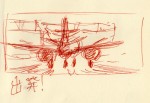

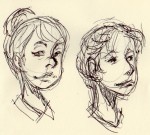


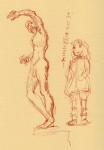

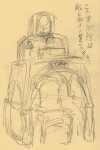
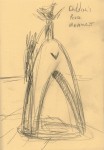
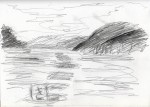

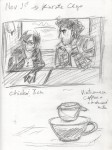



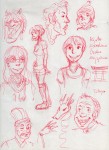
beautiful post, you described everything so well, and I love the quick sketches